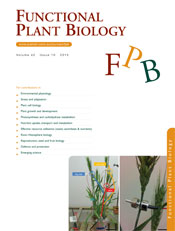
Functional Plant Biology
Volume 42 Number 10 2015
FP15025Genetic approaches to enhancing nitrogen-use efficiency (NUE) in cereals: challenges and future directions
Australian farmers apply large amounts of nitrogen fertiliser to cereal crops to achieve high yields and maintain grain quality. The use of this applied nitrogen fertiliser by cereals is poor, and leads to economic losses and environmental problems. This review details the problem in an Australian context and details genetic approaches to improve the use of nitrogen fertiliser by cereal plants.
FP15041Genetic diversity for root plasticity and nitrogen uptake in wheat seedlings
Enhancing nitrogen (N) use efficiency of crops is a global research priority aimed at reducing costs of production and environmental pollution. In this study, diverse wheat genotypes were analysed for root N responses, N flux capacity and expression of N transporter genes. All wheat genotypes responded to low N with enhanced root growth, but differed in their ability to accumulate N. Identifying plant responses to N will assist breeders with developing wheat cultivars that can cope with changing soil nutrient availability.
FP15133Cellular pathways of source leaf phloem loading and phloem unloading in developing stems of Sorghum bicolor in relation to stem sucrose storage
Sugar accumulation in Sorghum bicolor stems is an important biofuel resource. We demonstrate that phloem loading is apoplasmic and phloem unloading in developing stems shifts from an apoplasmic to a symplasmic route, coinciding with the onset of sucrose accumulation. This knowledge will inform future studies targeting increases in sugar storage.
FP15033The significance of image compression in plant phenotyping applications
The use of cameras and image processing solutions has considerably increased the throughput of phenotyping experiments. Data are typically compressed by manufacturers (unknown to users) or end-user choice to save storage space. We demonstrate that lossy image compression affects the extraction and analysis of visual traits from plant images. Via a thorough comparison of state-of-the-art approaches, we identify suitable compression options and best practices for a variety of typical phenotyping applications.
FP15103Re-analysis of plant CO2 responses during the exponential growth phase: interactions with light, temperature, nutrients and water availability
The CO2 response of plant growth remains one of the most uncertain aspects of plant performance under climate change despite many years of research. This is partly caused by an incomplete and confounded analysis of past experimental observations, which we aimed to rectify by reanalysing published research results to derive an unconfounded assessment of growth responses. This provided new insights into plant CO2 responses that partly confirmed theoretical expectations, but conflicted with others, such as not showing the theoretically expected temperature × CO2 interaction.
FP15103 Abstract | FP15103 Full Text | FP15103PDF (636 KB) | FP15103Supplementary Material (304 KB) Open Access Article
FP15087Simultaneous recording of diurnal changes in leaf turgor pressure and stem water status of bread wheat reveal variation in hydraulic mechanisms in response to drought
Information about water relations within crop canopies is needed to improve our understanding of canopy resource distribution and crop productivity. This study involved continuously (and non-destructively) monitoring water status of different organs of wheat plants, and showed that flag leaves have superior turgor maintenance over penultimate leaves under drought, whereas turgor oscillated during post-drought recovery in leaves and stems. These traits are expected to be beneficial for grain filling and maintaining yield.
FP15135Response of leaf water status, stomatal characteristics, photosynthesis and yield in black gram and green gram genotypes to soil water deficit
Stomatal behaviour plays an important role in plants’ response to environmental stress. This study documents the differences in drought tolerance at leaf and stomatal level of two drought susceptible pulses – black gram and green gram. Genotypic variability has been observed in both the pulses and between the two crops, green gram was found to be affected to a greater extent than black gram. Findings of this study will be useful for future breeding programs aimed to improve drought resistance in black gram and green gram.




